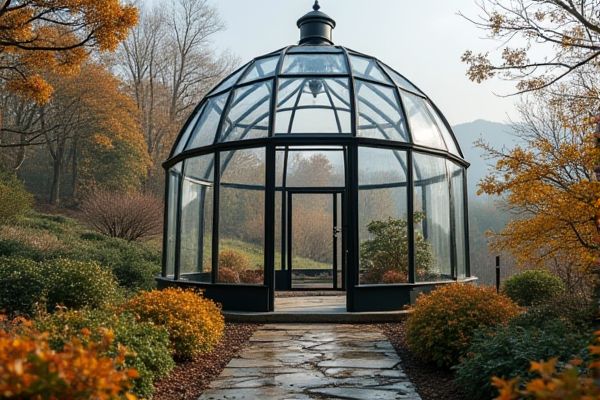
A cold frame is a low, box-like structure with a transparent lid that traps sunlight to protect plants from frost, ideal for extending the growing season in small garden spaces. A hoop house is a larger, tunnel-shaped greenhouse made of flexible hoops covered with plastic, designed to create a controlled environment for growing crops year-round; discover which option best suits Your gardening needs by reading the full article.
Table of Comparison
| Feature | Cold Frame | Hoop House |
|---|---|---|
| Structure | Low, transparent-topped enclosure | Arched, tunnel-like plastic-covered frame |
| Purpose | Protect seedlings and extend growing season | Extend growing season for larger crops and plants |
| Size | Small, usually 2-4 feet high | Larger, can cover entire garden beds |
| Temperature Control | Passive heat retention via glass or plastic cover | Better air circulation with side vents, passive heating |
| Wind Protection | Moderate | High |
| Cost | Low to moderate | Moderate to high |
| Durability | Seasonal, less durable | More durable, reusable |
| Best For | Seed starting, small plants | Vegetables, shrubs, extended season crops |
Introduction to Cold Frames and Hoop Houses
Cold frames and hoop houses are essential structures for extending the growing season and protecting plants from harsh weather. Cold frames consist of low, transparent-roofed enclosures that trap solar heat to create a warm microclimate, ideal for seed starting and hardening off seedlings. Hoop houses are larger, tunnel-shaped structures made from metal or PVC frames covered with polyethylene, providing ample space for cultivating multiple crops while maintaining consistent temperature and humidity levels.
Defining Cold Frames: Key Features
Cold frames are low, protective structures that trap solar heat to extend the growing season and shield plants from frost. Typically made from a transparent lid mounted on a wooden or metal frame, cold frames rely on passive solar energy and maintain a controlled environment for seedlings or tender plants. Your garden benefits from their compact size and ease of use, ideal for starting seeds early or hardening off plants before transplanting.
Understanding Hoop Houses: Structure and Benefits
Hoop houses feature curved frames typically made from metal or PVC pipes covered with polyethylene film, creating a versatile and durable structure for extending growing seasons. They provide superior protection against frost and wind while allowing ample sunlight penetration, promoting healthy plant growth. The lightweight design and ease of assembly make hoop houses ideal for both commercial and home gardeners seeking enhanced crop yields.
Temperature Control: Cold Frame vs Hoop House
Cold frames provide more precise temperature control by trapping solar heat in a compact, insulated space, ideal for seed starting and extending the growing season by a few weeks. Hoop houses, larger and with more ventilation options, offer greater airflow but less consistent temperature regulation, suitable for protecting larger crops over extended periods. Choosing between the two depends on the specific temperature needs and scale of the gardening project.
Space and Size Considerations
Cold frames occupy minimal space and are ideal for small gardens or urban settings due to their compact design, typically ranging from 2 to 6 feet in length. Hoop houses require significantly more area, often spanning 10 to 30 feet or more, accommodating larger crop volumes and allowing for vertical growth. Gardeners with limited space benefit from cold frames, while hoop houses suit those managing extensive planting beds or commercial operations.
Cost Comparison: Initial Investment and Maintenance
Cold frames typically require a lower initial investment, often ranging from $50 to $200 for basic models, making them an affordable option for small-scale gardeners. Hoop houses involve higher startup costs, between $300 and $1,500, due to the need for durable materials such as metal hoops and polyethylene covers. Maintenance for cold frames is minimal, usually involving occasional glass or acrylic panel replacements, while hoop houses demand regular inspection and repair of plastic coverings and structural supports to withstand weather conditions.
Crop Selection: What Grows Best in Each
Cold frames excel at nurturing heat-loving crops such as tomatoes, peppers, and basil by providing a warm, protected environment ideal for early seedling growth. Hoop houses are better suited for larger crops and extended growing seasons, supporting cold-tolerant vegetables like kale, spinach, and broccoli through colder months. Crop selection hinges on temperature needs and space requirements, with cold frames favoring seedlings and hoop houses accommodating mature plants.
Ease of Installation and DIY Potential
Cold frames offer straightforward installation with simple materials like wood and glass or plastic, making them highly accessible for DIY enthusiasts. Hoop houses require more structure preparation and PVC or metal hoops, which may demand basic tools and moderate construction skills. Your choice depends on how hands-on you want to be and the level of effort you're willing to invest in setup.
Season Extension Capabilities
Cold frames provide effective season extension by trapping solar heat and protecting plants from frost, allowing earlier planting in spring and prolonged harvests into late fall. Hoop houses offer larger growing spaces with superior insulation and temperature control, enabling more significant temperature moderation and extended growing seasons through winter. Your choice depends on the scale of your garden and the degree of season extension needed for optimal crop production.
Choosing the Right Structure for Your Garden
Cold frames provide a compact, low-cost solution ideal for extending the growing season by protecting seedlings and delicate plants from frost, while hoop houses offer larger, versatile protection suitable for a wide range of crops and longer-term cultivation. Hoop houses utilize a curved frame covered with polyethylene, creating a warm microclimate that supports temperature regulation and humidity control, making them more suitable for extensive garden projects. Selecting between a cold frame and a hoop house depends on garden size, budget, and specific crop requirements, with cold frames preferred for small-scale, intensive gardening and hoop houses for larger production and diverse plant varieties.
 homyna.com
homyna.com